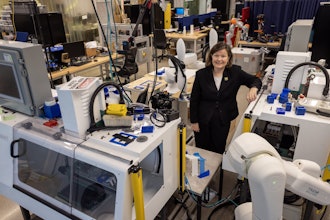
Throughout my career, my teams and I have driven transformative changes worth billions of dollars for hundreds of companies. As someone who has spent decades helping enterprises transform their most important systems, I’ve seen firsthand how innovation can redefine success.
In the last couple of years, likely due to AI, I have seen this success multiply on an exponential scale. Double-digit returns used to be rare; now, an innovation that creates revenue growth of only 10% doesn’t even hit my news feed. In today’s fast-paced industrial distribution landscape, staying ahead of the competition means more than just keeping up with the latest trends — it requires a deep understanding of the transformative technologies that can propel a business forward.
One example of these incredible results is Endries International, a company that has harnessed the power of generative AI to achieve remarkable growth and efficiency.
The Endries International Success Story
 Endries International
Endries International
This all changed when Endries reached out to Infor to see if there was a good use case to embrace generative AI. Endries and Infor’s Augmented Intelligence Services team integrated this cutting-edge technology into their operations, automating the laborious process of part-matching and enabling their team to focus on more value-added activities. As Endries CEO Michael Knight put it in a recent discussion, “It was about transforming our workforce from doing mundane tasks to doing virtuous activities that truly add value to our customers.”
Imagine a seasoned angler who, instead of struggling with tangled lines and faulty reels, suddenly finds themselves with the best gear on the market. That is exactly the type of boost Endries got with gen AI. Endries was able to streamline their processes, saving an incredible 7,200 hours per year in part matching alone. This freed up their employees to do what they do best — ensuring they had the right vendor support to maximize the value of every sale. No longer bogged down by minutiae, the team could focus on strengthening relationships with suppliers, fine-tuning its vendor-managed inventory program and delivering unparalleled service to customers.
This shift wasn’t just about efficiency; it was about empowerment. By offloading the repetitive tasks to AI, Endries’ workforce could concentrate on strategic initiatives that drove the company’s growth. The result? A 30% increase in their win rate.
The impact of this transformation extends far beyond the numbers. It’s about the peace of mind that comes with knowing your operations are running smoothly and your customers are getting the best possible service. Endries International’s success story is one of embracing change and turning challenges into opportunities. With the right tools and mindset, they’ve proven that even the most daunting tasks can be streamlined, allowing their team to focus on what truly matters — driving value for their customers and ensuring long-term success.
As Knight reflected, “Our team is no longer just reacting to problems; we’re proactively shaping the future of our industry.” When you catch a 30% increase in wins AND you save many years of labor, you quickly realize there is no thrill quite like reeling in these kinds of results.
Five Steps to Stay Ahead with Gen AI
For businesses looking to emulate Endries’ success, it’s important to understand that getting results from adopting gen AI isn’t a one-size-fits-all solution. It requires a strategic approach tailored to the unique challenges and opportunities within your organization. Here’s how you can stay ahead of the trend:
1. Strategic Roadmap Development: The first step to successful gen AI adoption is creating a strategic roadmap that aligns with your organization’s goals. This roadmap should sequence the steps of implementation while addressing contemporary industry threats, such as increased disintermediation and nontraditional disruptors like pure e-commerce players. Think of it like planning a fishing trip: you need to know where you’re going, what you’re aiming to catch and how you’re going to get there. A well-defined roadmap will serve as a sonar system, helping your organization navigate the complexities of transformation with confidence.
2. Use Case Selection: Not all use cases are created equal, and it’s crucial to focus on those that will deliver the greatest impact. Leaders should prioritize a list of use cases within their organization, ensuring that gen AI is directed toward the areas with the highest potential for improvement. For industrial distributors, this might mean using gen AI to create bespoke customer solutions that meet the rising expectations for convenience and service. It’s much like choosing the right Scotch to pair with a fine meal on that fishing trip — get it right, and the results are unforgettable. By zeroing in on high-impact use cases, you can maximize the value of your gen AI investment.
3. Use Case Execution: Once you’ve identified the most promising use cases, the next step is execution. This involves adapting existing enterprise-grade solutions to your specific needs and building robust ecosystems around your gen AI tools. It’s essential to ensure that these tools fit seamlessly into your current enterprise architecture and are rigorously tested against anticipated customer use. The goal is to integrate gen AI in a way that enhances, rather than disrupts, your operations — like setting the perfect drag on a fishing reel. You want smooth execution that leads to a successful catch without any hitches.
4. Governance: As with any powerful technology, the implementation of gen AI must be accompanied by strong governance. This means establishing centers of excellence staffed by cross-functional teams of engineers, data scientists and experts in machine learning, ethics and risk management. A comprehensive risk management plan is also critical, detailing specific actions to address security, privacy and fairness concerns. Much like ensuring your fishing gear is well-maintained and your Scotch collection is top-notch, good governance is about attention to detail and preparation. With the right governance structures in place, you can ensure that your gen AI and automations tools are all used responsibly and effectively.
5. Change Management: Finally, adopting gen AI requires careful change management. Leaders must prepare their organizations for the transition by modeling positive use of the technology, fostering understanding and conviction among employees, and reinforcing adoption through incentives and goal setting. Additionally, companies need to invest in capability building to ensure that their teams have the skills necessary to develop, maintain and maximize the value of gen AI tools. This is akin to teaching a novice angler how to cast or guiding a friend through their first Scotch tasting — patience, encouragement and the right knowledge can make all the difference.
The industrial distribution industry is at a crossroads, and those who fail to adapt risk being left behind. By following the example set by Endries International and embracing gen AI and enterprise automation, distributors can achieve new levels of efficiency, innovation and customer satisfaction. But it’s not just about adopting the technology — it’s about doing so strategically, with a clear roadmap, focused use cases, strong governance and a commitment to change management.
As someone who has spent my career helping large enterprises transform, I can say with confidence that gen AI is not just the future of industrial distribution — it’s the present. The question is, will you be among the leaders who harness its power, or will you be playing catch-up as the industry evolves around you?
So take a page from Endries’ book: plan your strategy, execute with precision, and don’t forget to enjoy the journey — whether that means savoring a fine Scotch at the end of a successful day or basking in the glow of a well-earned business win.
Here’s to making the smart choice and reeling in those big wins. Cheers!
Mark Siner is the senior vice president of sales at Infor.























